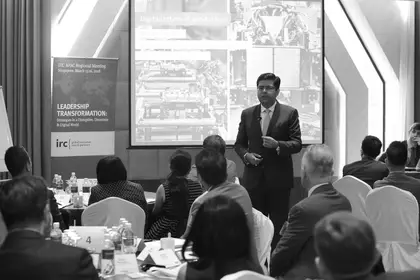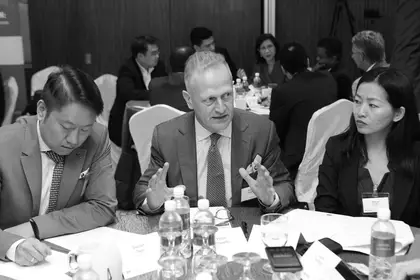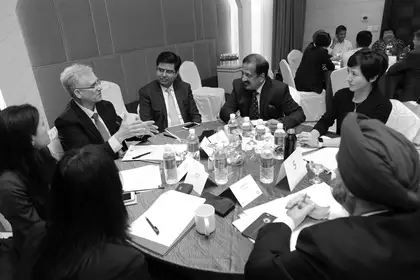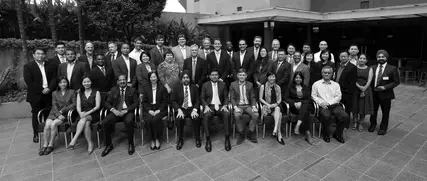Keynote speaker, thyssenkrupp AG Asia Pacific CEO Vivek Bhatia, shared how the €40 billion diversified industrial multinational that has thrived under three previous industrial revolutions is planning to take on Industry 4.0.
Some basic business philosophies remain relevant.
“Leaders must think beyond the products they want to provide but focus instead on the solutions to respond to the needs of customers,” he said. Bhatia shared four main leadership imperatives to survive and thrive during Industry 4.0.
Leadership competencies of the future
With the volatility and chaos characterising the business environment, it is even more important for leaders to set a clear purpose and direction for everyone in the organisation.
Innovation is one value that is a clear differentiator for many companies today. thyssenkrupp is one of the few industrial companies consistently named among the top 25 most innovative companies in the world.
The corporation has been innovating and embracing digitalization to address the needs of its customers through a variety of initiatives, for example, via its web portal titled “Materials for Me” where customers can order thyssenkrupp’s products online. In another example, the ERP system at leading manufacturing locations is connected to clients and suppliers to allow large degrees of operational flexibility to customers that traditional B2B environments cannot deliver.
The second key competency of leadership is to lead from the front and drive outcomes. The speed with which new challenges mushroom holds leaders more accountable. But the best leaders also join their teams in the trenches to solve bottlenecks within and outside the organisation enabling positive outcomes.
The third key imperative of leadership is securing talent pipeline. A talent management development plan must make individuals aware, not only of their performance, but the alignment of their own values to that of the organisation.
Companies today face tough competition from leading digital innovators and start-ups like Google, Facebook, Uber, and other disruptive businesses in hiring tech-savvy millennials.
Talents now are also less drawn by stability, a long history, or a big name. Instead, many are attracted by a company’s values and employment brand. Leaders have to be more innovative about communicating its value proposition to employees and talents and be aware of how their companies appear on social media platforms where the current generation decides which career and firm they will pursue.
The fourth and final leadership imperative is the alignment between a leader’s personal values and that of the organisation’s.
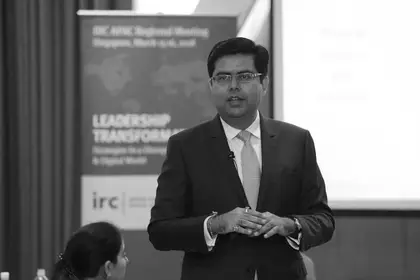
“This is about the individual himself. If the leader does not reflect the culture or values that he expects from his organization, it is impossible to expect subordinates to accept them. Any broad change in the organisation that is expected to last for years to come has to have the buy-in of leaders.” - Bhatia
The six themes that have arisen in the midst of the latest industrial revolution were discussed at Kestria APAC’s C-suite Roundtable:
- New technologies
- Constant change
- Connect & collaborate
- Markets & competition
- Learning & daring
- Uncertainty & unknown elements in the marketplace
These changes create new challenges for leadership. Thus, it becomes important for executive search firms to contribute to building a more relevant profile of the leaders of today.
New technologies
New technologies have created new customer segments and expectations, and competitors.
“Technology may be a threat to individual jobs, but if taken as an enabler in business, can create new roles and skills, and new jobs,” Kestria Malaysia and Thailand founding partner Manish Mehta said.
CropLife Asia executive director Tan Siang Hee said his business, which largely communicates and shares Good Agricultural Practices with farmers, is seeing both its B2B and B2C supply chains shortened thanks to the prevalence of smartphones in the farming community.
Meanwhile, big data is helping the agriculture industry reduce costs and increase efficiencies for distributors from the mix and tailoring products to farmers needs in sync with crop season.
With the added technology piece, businesses can now hire for jobs that did not exist five years ago. This nature of work will continuously evolve, as more facets of industry become digitised.
As formal education providers are slow to evolve, companies must take an active role in upskilling employees for new roles. HR is also called upon to help in the design and definition of new roles.
Constant change
Changes in the business environment are no longer sporadic but are happening constantly and at a more frenzied pace. This requires more agile responses to developments like the emergence of new competitors, new technological discoveries, the change or addition of distribution models for consumer products and the increasing sophistication of consumers, including millennials.
Multinationals are moderating bureaucratic tendencies by empowering local leaders in the APAC region to make quicker decisions, based on a more intimate knowledge of local market and competition. Global companies are also working closely with consultants or “experimental labs” to quickly respond to problems and opportunities. Singapore, for instance to companies which physically house start-ups. This allows business leaders to work directly and quickly with innovators.
Kestria APAC Regional Meeting 2018 in SingaporeConnect & collaborate
The millennia-old style of alpha management, hierarchy, and traditional command-and-control structure is giving way to shared leadership styles of open communication and employee empowerment, disrupting cultural stereotypes.
Leaders now support an environment that encourages and cross-pollinates ideas from the ground and among different business disciplines and industries.
The Kestria roundtable examined the evolution of the 130-year-old DSM (previously Dutch Steel and Mining) in making changes to better suit markets and the environment and be profitable while adhering to sustainability principles.
Sticking to its core purpose of Sustainability, DSM shaved off companies that did not align with the new business direction and brought more green businesses on board. It also grew CEOs from within. DSM's core purpose is built on a foundation of People, Profit and Planet, around which choices and decisions are made.
Evolutions such as this call on leaders who embody two key traits: living the core values of the organisation, internally and externally; and being proactive in planning for and anticipating potential risks much ahead. Internally, leaders have to ensure that the employees are invested in the organisation, with a shared sense of destiny, which then inspires them to welcome an empowered culture.
Such kind of leadership provokes critical thinking: challenging people, asking questions, and empowering them to be active participants in thinking through difficult business issues,” Kestria Malaysia and Thailand Managing Partner, Raj Kumar Paramanathan said.
On the flip side, transformation initiatives risk being delayed, if the leadership team overlooks the undercurrents that influence operations and underestimates the amount of time it will take to achieve goals. Execution teams can face enormous disruptions or distractions in the transformation journey. Identifying the support that employees need, whether coaching, new skills training or technology will reduce the likelihood of failure.
Markets & Competition
Compared to previous industrial revolutions, Industry 4.0 is making competition fiercer and multi-directional. The focus now has shifted to Value-to-Customer (and not product).
International Hotel Supply Company, which distributes products to hotel chains globally, is seeing the surge in Airbnb listings affecting their business.
“Given that the largest Airbnb market in Asia is Indonesia, we are evolving to find more sophisticated ways to reach out to this new set of potential customers. In the USA, we have added a B2C platform to our traditional B2B model,” International Hotel Supply Company managing director (Asia) Miles Wilson shared.
Peter Thewlis at the C-suite roundtable discussion hosted by KestriaPrivate equity independent consultant Peter Thewlis meanwhile noted that competition also extends to channels that may sometimes support or oppose each other.
“For instance, brick-and-mortar fashion houses are challenged by sites like Net-a-Porter online, but at the same time, there are sites like Farfetch who are supportive of traditional retail and deliver luxury goods to a consumer’s doorstep within hours. Solutions like this help luxury retail players enter the online business quicker,” Thewlis said.
The increased diversity in both markets and competition call on leaders to continuously take a pulse on trends. Teams also need to be more collaborative both internally and externally with other channels to share information and take advantage of opportunities.
Learning & Daring
In today’s environment of uncertainties, repeating the same management practices that have proven to be effective in the past is no longer a guarantee of future success. Millennials are not only sensitive to how companies can quickly adapt to megatrends, but they also want to join or buy products and services from companies whose values align with their own. There is a shift in focus from profits to purpose. To engage millennials and all others entering the workforce in the future; leaders need to be conscious of leading with purpose.
The Roundtable also revealed that some multinationals had changed the mindset about leadership maturity. Historical norms are being rewritten. The traditional climb up the career ladder is being challenged. Age boundaries are almost non-existent as the lines on who should lead are becoming blurred. Some are appointing young country heads in their mid-twenties to Country Head positions in smaller markets. They take this risk not only to meet career expectations and retain young high potentials but also because digital natives have an advantage in the new economy.
Also, the education system in many countries is challenged to keep pace with technological change. One example shared was where a company had resorted to creating a university to educate the talent they needed for their business.
“Learning and daring also affect how often a company can embrace change,” Kestria South Korea President Steven B. McKinney said.
C-suite roundtable discussion hosted by KestriaUncertainty & Unknown Elements in the Marketplace
VUCA elements call for leadership that is strong and smart enough to know when a current strategy is not working. This can be a monumental task for larger companies with multiple revenue streams and global operations.
Sanofi regional talent management lead Annie Lim shared how the 120,000-strong corporation hired consultants from the Big 5 consulting firms who had previously done work for Sanofi. This group is tasked to create an internal strategy team that would streamline strategy across multiple global business units (GBUs).
In strategising, the Kestria roundtable concluded that leaders should place emphasis on threat analysis within the SWOT model. Too often leaders are focused on what they do best, not what is likely to take business away. Instead of merely asking “How can we win?”, leaders should also ask “How can we lose?”
“Leaders need to also focus on what would be destructive for their businesses. A leader also has to be very agile, able to make quick changes and be cognizant of the fact that failures are fine, but you need to fail fast and have the courage to make necessary changes promptly,” Hill-Rom APAC regional marketing director Angela Low said.
Executive Summary
Companies are adapting to the VUCA environment by adopting new technologies, and new business and distribution models that allow them to communicate with and respond to individual needs of customers. Leaders must therefore have the capability to build a vision around the new technologies and to establish new external partnerships.
In the midst of the chaos and transformation, it becomes even more important for leaders to articulate a clear purpose and direction, to be alert to risks in the environment, to forge an empowering environment that allows responsible risk-taking, greater participation from employees and agility in decision-making. Millennials as consumers, employees and leaders are also impacting businesses with their social advocacies and with the technological savviness that is second nature to them. The paradox is that while the changes are mostly technology driven, many “soft” leadership competencies like humility, listening to others, forging teamwork, being self-aware about one’s own values etc. are becoming even more important.
What kinds of transformations must today’s leaders embrace to thrive in Asia now and in the future?
- From Expert to Learner. Everyone can be considered a newbie because of how the new technologies are creating new jobs and transforming business processes and models. A Microsoft survey has shown that one of the major challenges to digitalization in some Asian countries is the lack of top management competency to “ideate, plan and execute digital transformation. “Leaders need to be literate in big data analytics and the new technologies and be able to drive and participate in discussions related to digitalization.
- From a directive and authoritarian style to empowering leadership. Leaders must listen and be prepared to learn from and empower their team, without abdicating leadership responsibilities like direction-setting. For instance, he or she must be comfortable with learning from and consulting younger members of the team who are digital natives and are more competent in working with the new technologies. A leader also needs to listen to people in order to create an empowered culture that results in greater sharing of information and more agile responses. Many millennials prefer to work in more open cultures where their views are valued. Since the war for talent will continue to intensify, an empowered culture strengthens a company’s employment brand.
- From a utilitarian perspective to one that is value-driven. Consumers and employees have become more discerning and the practice of social responsibility is driving sustainable business results. Leaders must therefore be keenly aware of how their own values and decisions align with the company’s True North.
- From homogeneous global leadership to one rooted in both universal principles and distinct cultural norms. More multinationals are localizing top leadership or giving greater decision-making powers to Asian leaders, debunking the notion that Asian culture does not produce strong global leaders. To be sure, there are enduring leadership traits and competencies common in all cultures. Leaders from Asia, especially from some Southeast and North Asian countries have the added challenge of building on the positive aspects of their culture but also leading change to overcome impulses that inhibit the openness and risk-taking necessary for innovation and agility. Asian leaders are called to build on the teamwork and harmony that are strengths of Asian cultures on the one hand, and on the other to wean people away from the dysfunctional conformity often present in traditional hierarchal organisations. As one employee puts it.” it is easier for the person on top to go down than for the person at the bottom to struggle to climb up.”
